Top 10 Things to Do in Tempe, Arizona
What draws people to Tempe, Arizona? You might not have ever heard of this city east of Phoenix, but it’s no mere Phoenix suburb.
Tempe (pronounced “tem-PEE”) is home to the main campus of Arizona State University—one of the country’s largest public research universities—so you’ll often see people coming to this college town to drop off their kids at college or to attend academic conferences. Businesses like operating in a community with an educated workforce, so regional headquarters and office towers dot the city from north to south. Plus, Tempe’s location in the middle of the Phoenix metro area makes it an ideal home base for tourists exploring the region.
Folks visiting Tempe and looking for things to do will often be told to check out places technically in Phoenix or Scottsdale, like the Desert Botanical Garden, Old Town Scottsdale, or even county parks and national forests. These are all great places to go to, but…
What if you wanted to do fun and interesting things while never leaving Tempe city limits?
There’s plenty to keep you busy within Tempe’s 40 square miles (tiny by the standards of Phoenix’s sprawling suburbs). I moved to Arizona for work in 2016 and landed in Tempe, where I made a home for myself for the first time since moving back to the States from Spain. Although I’m downtown Phoenix resident now, I was—and still am—impressed by how much there is to do in Tempe!
I hope my recommendations in this blog post inspire you to visit Tempe the next time you’re in Arizona. By sticking to activities exclusively within Tempe, you’ll have the freedom to ditch your car and explore town on foot or by bus or train. You can do everything on this list within a short walk of downtown Tempe or via a quick ride on the city’s many public transit options.
Longtime Tempe residents aren’t happy about all the corporate chain restaurants, stores, and pharmacies that have flooded in since the “glory days,” when Mill Avenue was the coolest place to be in the Phoenix area, but there are still plenty of local businesses—shops, bars, or eateries—that keep Mill hip…and a little weird.
It’d be easy to spend a whole evening going on a bar crawl, and you’d be forgiven for burning through all your cash while shopping. If you’re into indie films, see what’s playing at Valley Art, the oldest theater in the Phoenix Valley operated by Arizona-based Harkins Theaters.
I enjoy taking in Mill Avenue’s atmosphere. Pedestrians fill the sidewalks of Tempe’s most walkable neighborhood, crossing beneath mature shade trees and past historic storefronts. At the corner of Mill and 5th Street, the Laird and Dines building takes you back to when Arizona was just a territory.
If you keep walking down Mill south of busy University Drive, you’ll reach the historic Maple-Ash neighborhood. The micro-climates of established, towering shade trees will immediately cool you off from the Arizona heat.
Instead of installing xeriscaped (low-water) landscapes, homeowners in Maple-Ash still water their lawns the traditional Arizona way: by flood irrigation. This relic from Tempe’s agricultural past recalls how river water was channeled through a series of canals to grow crops in the desert. Look for raised, grassy berms that hold miniature floods inside property lines as well as decorated standpipes that regulate the flow of water through subterranean canals.
You can encounter the magic of water in the desert by renting a kayak or a paddleboat and floating from one end of the lake to another. Cars will pass above your head on the New Deal-era Mill Avenue bridge while freight trains or light rail vehicles roll by on parallel bridges.
You can also go walking, jogging, or biking on half a dozen miles of protected, paved trails that circle the lake and riverbed. No bike? No problem! Just rent a Grid bike at any of four hubs around the lake and pedal away.
Y’all remember the Pokémon Go craze of 2016? It’s still A Thing, by the way. With a gym or two, PokéStops galore, and even water Pokémon, Tempe Town Lake is Pokémon Go central. Come catch ’em all—and get all your steps in. If you’d prefer something more tangible, you can always go fishing. The Arizona Game and Fish Department stocks the lake with trout—just get a fishing license first.
Most flights arriving at Phoenix–Sky Harbor International Airport roar overhead, which means you can watch airplanes land at one of the country’s busiest airports from a mountaintop perch. Look for British Airways Flight 289, a jumbo jet that lands daily around 5:30 p.m. This direct flight from London made Phoenix an international destination when service began in 1996.
As you zig-zag your way up the hillside, try spotting a few petroglyphs between the creosote bushes and barrel cactuses. These striking examples of rock art were left by the prehistoric Hohokam people, who dug irrigation canals and created a vast agricultural civilization 1,000 years ago in what is now central Arizona. Native Americans from the nearby Salt River Pima–Maricopa Indian Community identify the Hohokam as their ancestors and consider Hayden Butte sacred.
That big golden letter A on the side of the mountain? It’s one of many letters you can find on mountainsides across Arizona, but this one represents the “A” in Arizona State University. Students at rival University of Arizona often try to paint the letter in U of A-themed red and blue, so ASU students will stand vigil on the mountain whenever the two schools play each other in college football.
Arizona’s biggest craft brewery (and one of its oldest, dating back to 1996) operates in a warehouse east of ASU. Four Peaks Brewery offers beer on tap and bar food as well as free tours of their extensive brewery. Their historic location used to be a creamery, and before that it was an ice house in territorial days, so it’s understandable that they claim it’s haunted! Wash away the spookiness with their popular Kilt Lifter, a Scottish-style amber ale. They take their name from a series of four mountains that rise more than 7,500 feet northeast of the Phoenix area: the Four Peaks.
They did “sell out” to multinational beer giant Anheuser-Busch InBev in 2015, but at least according to this report from the Republic, the takeover has allowed them to make major upgrades to their two brewing facilities—all while retaining local control of operations. Thanks to the acquisition, you can now find Four Peaks brews in taps and liquor stores outside Arizona.
To get to Four Peaks Brewery (1340 East 8th Street #104), take the light rail east toward Mesa, get off at the Dorsey Lane and Apache Boulevard stop, and then walk north on Dorsey. Alternatively, ride the free Orbit Mercury circulator toward Escalante Center and get off at Dorsey and 8th Street.
Looking to take shelter from that hot Arizona sun? Hop around the shadows cast by the avant-garde architecture of the ASU Art Museum on the western edge of campus. While you’re there, enjoy any of the free temporary exhibitions that feature contemporary art from across the country and the world. Admission is free for students and non-students alike.
Find the ASU Art Museum (51 East 10th Street) at the southeast corner of Mill Avenue and 10th Street.
Off-Broadway musicals. Classical performances by students at the ASU School of Music. All that and more takes to the stage of a circular auditorium named for longtime ASU president Grady Gammage. Architect Frank Lloyd Wright took plans for an opera house originally intended for Baghdad, Iraq, and repurposed them for another riverside desert community.
ASU Gammage (1200 South Forest Avenue) sits right inside the curve made by Mill Avenue as it bends southeast into Apache Boulevard.
Tempe Center for the Arts sits mere feet from the lapping waters of Tempe Town Lake’s south shore, its geometric roof sheltering a complex with two theaters and an art gallery. Home to multiple community arts groups, the center also hosts open mic night on Wednesdays for musicians and poets.
The 48 bus toward Priest/Baseline will drop you off right in front of the entrance to Tempe Center for the Arts, whose address is 700 West Rio Salado Parkway.
Tempe’s Diablo Stadium is the spring training home of the Los Angeles Angels. This tradition of spring training has taken place across the entire Phoenix Valley since the 1940s, and today, half of the nation’s MLB teams practice here—to the delight of all the transplants from California and the Midwest. You can watch the Angels play laid-back spring training games in Tempe from late February through most of March.
Tempe Diablo Stadium (2200 West Alameda Drive) sits just south of the Marriott Phoenix Resort Tempe at the Buttes inside the “Broadway Curve” of Interstate 10. From downtown Tempe, take the 48 bus toward Priest/Baseline and get off at 48th Street and Roeser Road/Alameda Drive.
In addition to petroglyphs from the prehistoric Hohokam people, Tempe’s also got hilltop ruins from the same era that overlook Tempe Town Lake. Archaeologists excavated the Loma del Rio ruins in 1928, but they carefully buried the crumbling adobe walls in earth in 1994 to protect them against erosion, a common strategy in the Southwest to save dwellings like this one for future studies. What we can see today in Papago Park is just a handful of stones, but the site is evocative nonetheless.
The Loop 202 Red Mountain Freeway was first paved through here in the mid-1990s. Its construction created an awkward no man’s land north of the highway and south of an old Papago Park canal. Volunteers worked with the city to revegetate this strip of land by planting mesquite trees native to the Sonoran desert. The LoPiano Mesquite Bosque (Spanish for “forest”) has created a habitat for wildlife and a soothing, shaded place to walk on a summer day.
Find Tempe’s slice of Papago Park north of Tempe Town Lake and State Route 202. If you’re already spending time on the lake, these ruins and the mesquite bosque are nice detours easily accessed on foot via the Mill Avenue bridge. Otherwise, simply drive to the Papago Park parking lot at the intersection of College Avenue and Curry Road or the parking lot on the lake’s north shore further down the road. The free Orbit Earth circulator toward Tempe Marketplace will also drop you off nearby.
Arizona was known as the Baby State for decades after it gained statehood on Valentine’s Day, 1912, but the state has one of the country’s richest and most interesting backstories. Spend a quiet morning or afternoon at the Arizona Historical Society’s Tempe branch to learn all about the contributions the original inhabitants of the land have made to Arizona history as well as those made by the various waves of settlers who have come to this corner of the Southwest.
Don’t miss the mineral exhibit that showcases Arizona’s mining heritage or a hall that reconstructs the path a series of UFOs called the Phoenix Lights took in the late 1990s.
The Arizona Heritage Center is tucked inside the Tempe portion of Papago Park at 1300 North College Avenue. From downtown Tempe, ride the free Orbit Earth circulator toward Tempe Marketplace and get off at College Avenue and Curry Road.
As much as I complained about noise and traffic closures when I lived by Tempe Town Lake, I have to hand it to the city for doing their best to host several dozen major special events either downtown or along the lake. They really make the city a fun place to live in! From a New Year’s Eve block party on Mill Avenue and the state’s best Independence Day firework show, to 5Ks, a marathon, and the Ironman triathlon event, there’s always something going on around Tempe Beach Park throughout the year. Check out the community calendar here.
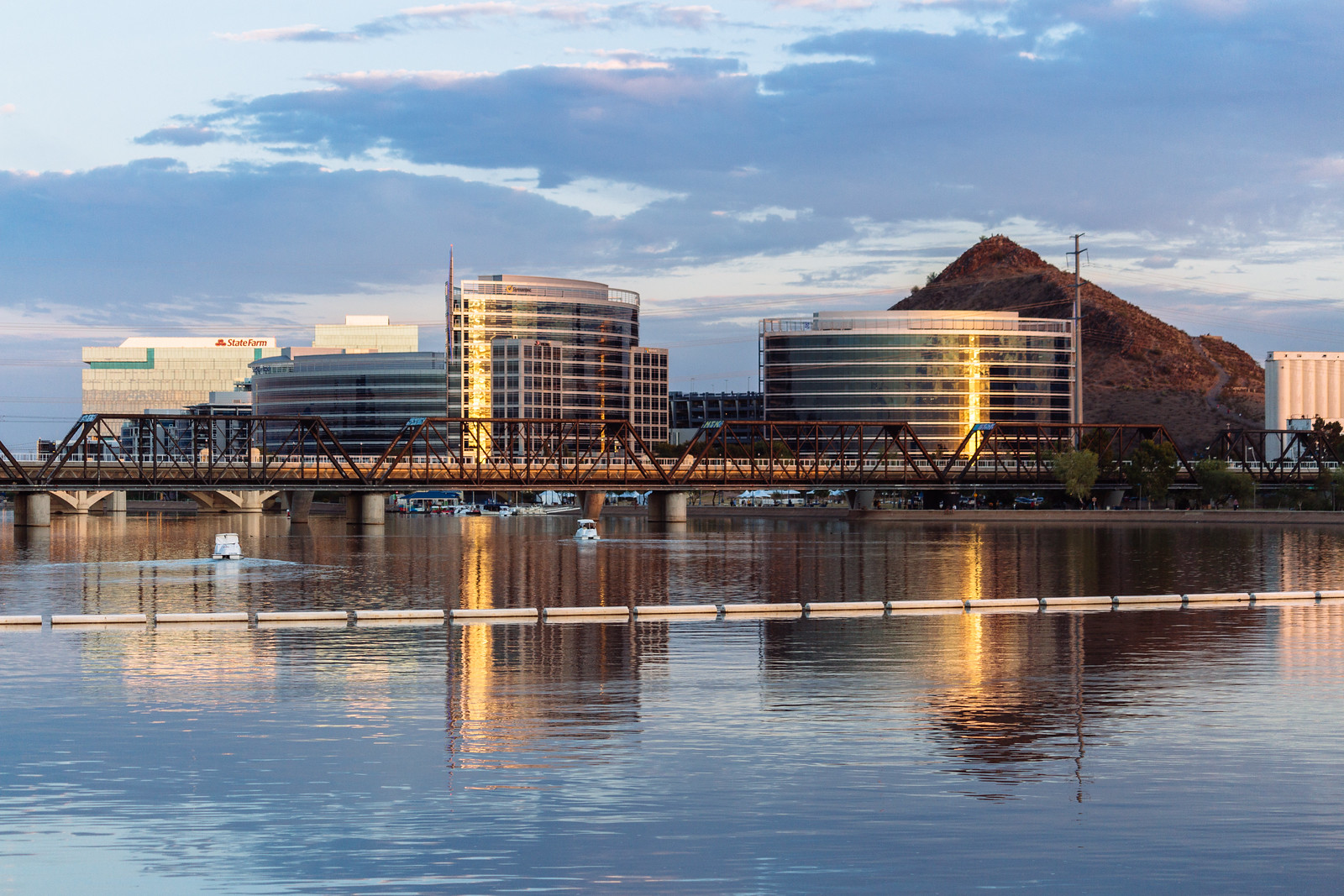 |
| Downtown Tempe skyline reflected on Tempe Town Lake |
Tempe (pronounced “tem-PEE”) is home to the main campus of Arizona State University—one of the country’s largest public research universities—so you’ll often see people coming to this college town to drop off their kids at college or to attend academic conferences. Businesses like operating in a community with an educated workforce, so regional headquarters and office towers dot the city from north to south. Plus, Tempe’s location in the middle of the Phoenix metro area makes it an ideal home base for tourists exploring the region.
Folks visiting Tempe and looking for things to do will often be told to check out places technically in Phoenix or Scottsdale, like the Desert Botanical Garden, Old Town Scottsdale, or even county parks and national forests. These are all great places to go to, but…
What if you wanted to do fun and interesting things while never leaving Tempe city limits?
There’s plenty to keep you busy within Tempe’s 40 square miles (tiny by the standards of Phoenix’s sprawling suburbs). I moved to Arizona for work in 2016 and landed in Tempe, where I made a home for myself for the first time since moving back to the States from Spain. Although I’m downtown Phoenix resident now, I was—and still am—impressed by how much there is to do in Tempe!
I hope my recommendations in this blog post inspire you to visit Tempe the next time you’re in Arizona. By sticking to activities exclusively within Tempe, you’ll have the freedom to ditch your car and explore town on foot or by bus or train. You can do everything on this list within a short walk of downtown Tempe or via a quick ride on the city’s many public transit options.
1) Walk down Mill Avenue and stroll through Maple-Ash
Mill Avenue, Tempe’s Main Street, takes its name from a ramshackle grain mill on the northern edge of downtown. The Hayden Flour Mill is more than 100 years old, and the Hayden family began milling grains grown across central Arizona even earlier, in 1874. Back then, agricultural Tempe was known as “Hayden’s Ferry,” a lonely crossing over the Salt River. One Carl Hayden would later represent Arizona for four decades in the U.S. Senate, where he fought for an aqueduct to bring the state’s share of Colorado River water to the Phoenix and Tucson areas.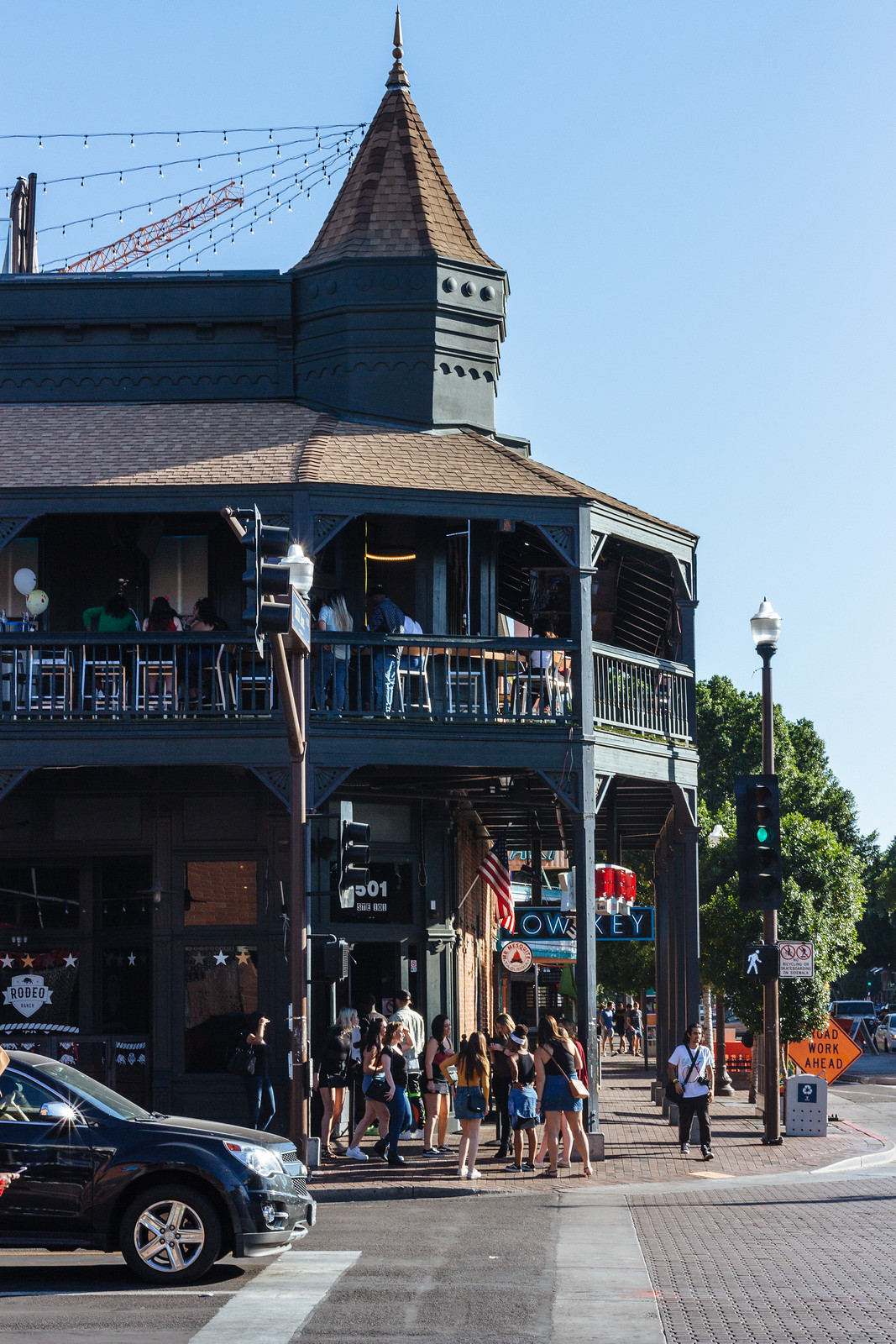 |
| The Laird and Dines Building (built in 1893) |
Longtime Tempe residents aren’t happy about all the corporate chain restaurants, stores, and pharmacies that have flooded in since the “glory days,” when Mill Avenue was the coolest place to be in the Phoenix area, but there are still plenty of local businesses—shops, bars, or eateries—that keep Mill hip…and a little weird.
It’d be easy to spend a whole evening going on a bar crawl, and you’d be forgiven for burning through all your cash while shopping. If you’re into indie films, see what’s playing at Valley Art, the oldest theater in the Phoenix Valley operated by Arizona-based Harkins Theaters.
I enjoy taking in Mill Avenue’s atmosphere. Pedestrians fill the sidewalks of Tempe’s most walkable neighborhood, crossing beneath mature shade trees and past historic storefronts. At the corner of Mill and 5th Street, the Laird and Dines building takes you back to when Arizona was just a territory.
 |
| Standpipe in the Maple-Ash neighborhood |
If you keep walking down Mill south of busy University Drive, you’ll reach the historic Maple-Ash neighborhood. The micro-climates of established, towering shade trees will immediately cool you off from the Arizona heat.
Instead of installing xeriscaped (low-water) landscapes, homeowners in Maple-Ash still water their lawns the traditional Arizona way: by flood irrigation. This relic from Tempe’s agricultural past recalls how river water was channeled through a series of canals to grow crops in the desert. Look for raised, grassy berms that hold miniature floods inside property lines as well as decorated standpipes that regulate the flow of water through subterranean canals.
2) Exercise at Tempe Town Lake
A manmade lake in the desert seems like an extravagance, but Tempe Town Lake has transformed what was once an actual dumping ground into one of the biggest destinations in the state and the site of $1.5 billion in private development. Two miles long and nearly a quarter mile across, the lake restores water to the historical course of the Salt River, now tamed behind four dams or diverted into irrigation canals.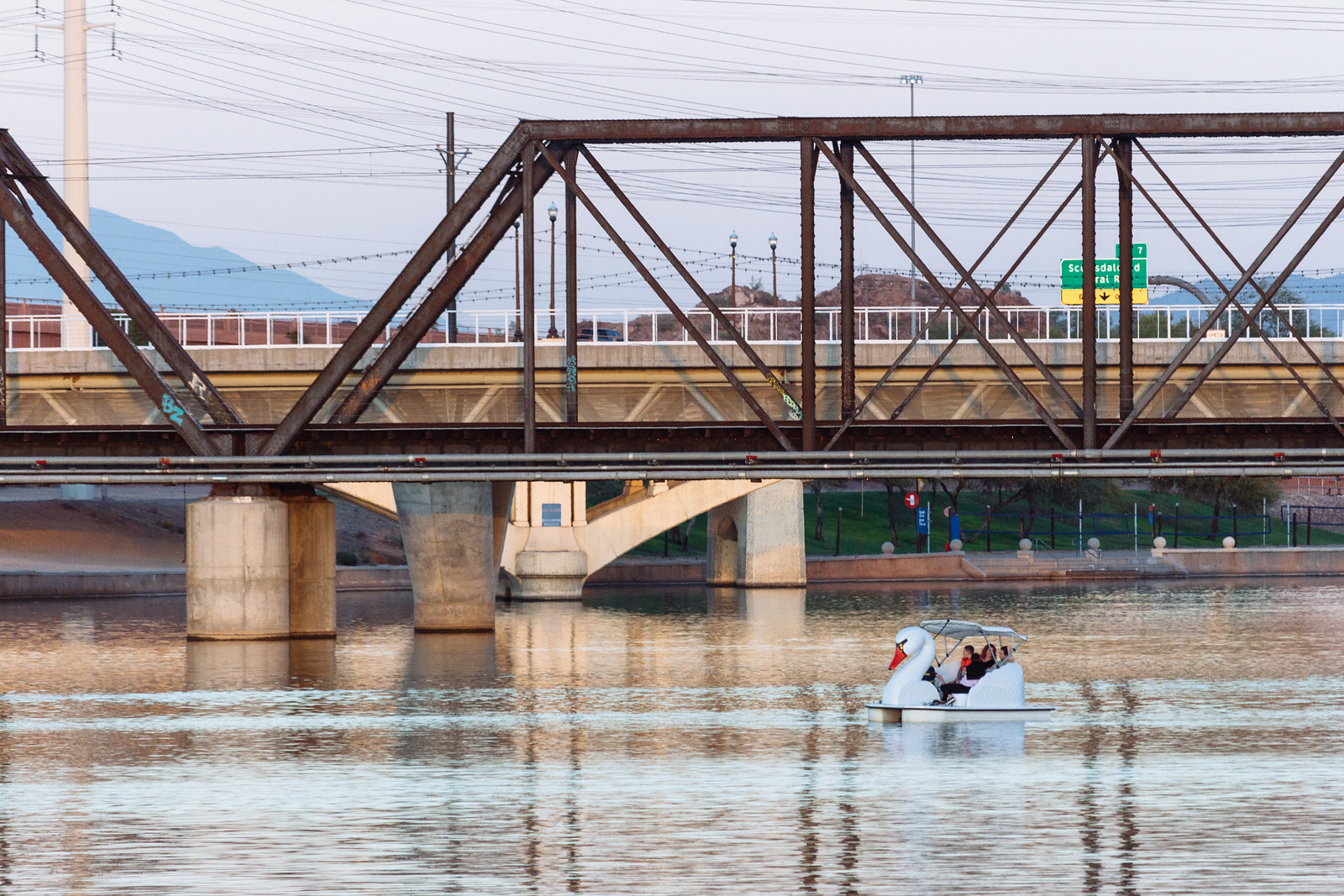 |
| Paddleboaters on Tempe Town Lake |
You can encounter the magic of water in the desert by renting a kayak or a paddleboat and floating from one end of the lake to another. Cars will pass above your head on the New Deal-era Mill Avenue bridge while freight trains or light rail vehicles roll by on parallel bridges.
You can also go walking, jogging, or biking on half a dozen miles of protected, paved trails that circle the lake and riverbed. No bike? No problem! Just rent a Grid bike at any of four hubs around the lake and pedal away.
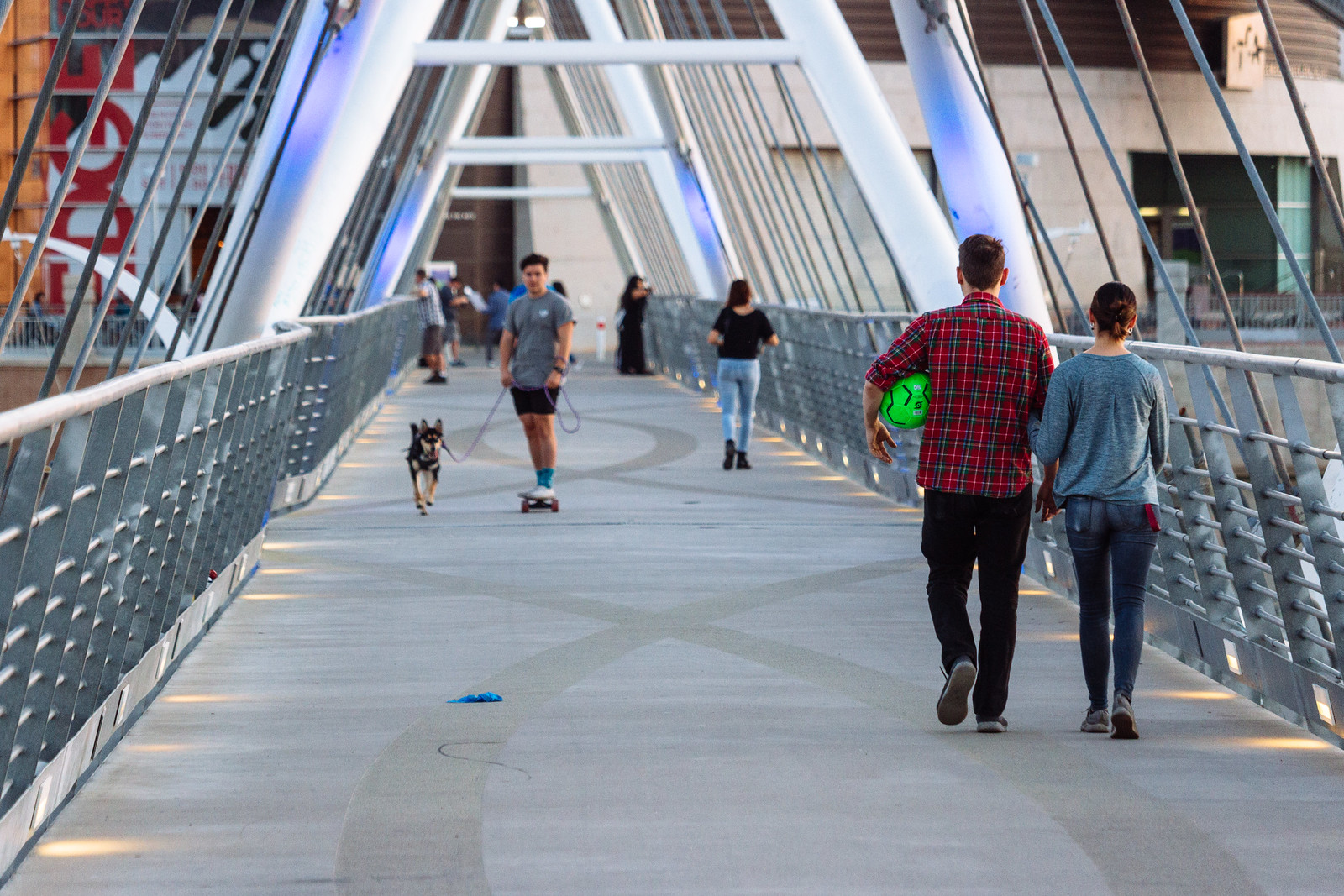 |
| Pedestrian bridge over Tempe Town Lake |
Y’all remember the Pokémon Go craze of 2016? It’s still A Thing, by the way. With a gym or two, PokéStops galore, and even water Pokémon, Tempe Town Lake is Pokémon Go central. Come catch ’em all—and get all your steps in. If you’d prefer something more tangible, you can always go fishing. The Arizona Game and Fish Department stocks the lake with trout—just get a fishing license first.
3) Hike Hayden Butte, a.k.a. “A” Mountain
With only 330 feet of elevation gain and less than a mile-long trail, Hayden Butte is perhaps the easiest hike in the Phoenix Valley. But this small butte is still quite steep, so it will really get your heart pumping. Lots of folks run up and down the mountain for endurance training, whether backwards or forwards, but I like to come up here for the panoramic views of the whole city. From up top, you can take in the iconic mountain peaks that surround the city, central Tempe and ASU fanning out below you, and TV and radio antennas on South Mountain glittering in the night.Most flights arriving at Phoenix–Sky Harbor International Airport roar overhead, which means you can watch airplanes land at one of the country’s busiest airports from a mountaintop perch. Look for British Airways Flight 289, a jumbo jet that lands daily around 5:30 p.m. This direct flight from London made Phoenix an international destination when service began in 1996.
 |
| Hayden Butte seen from Tempe Town Lake |
As you zig-zag your way up the hillside, try spotting a few petroglyphs between the creosote bushes and barrel cactuses. These striking examples of rock art were left by the prehistoric Hohokam people, who dug irrigation canals and created a vast agricultural civilization 1,000 years ago in what is now central Arizona. Native Americans from the nearby Salt River Pima–Maricopa Indian Community identify the Hohokam as their ancestors and consider Hayden Butte sacred.
 |
| The yellow letter “A” |
That big golden letter A on the side of the mountain? It’s one of many letters you can find on mountainsides across Arizona, but this one represents the “A” in Arizona State University. Students at rival University of Arizona often try to paint the letter in U of A-themed red and blue, so ASU students will stand vigil on the mountain whenever the two schools play each other in college football.
4) Tour Four Peaks Brewery
 |
| Kilt Lifter Scottish-Style Amber Ale |
Arizona’s biggest craft brewery (and one of its oldest, dating back to 1996) operates in a warehouse east of ASU. Four Peaks Brewery offers beer on tap and bar food as well as free tours of their extensive brewery. Their historic location used to be a creamery, and before that it was an ice house in territorial days, so it’s understandable that they claim it’s haunted! Wash away the spookiness with their popular Kilt Lifter, a Scottish-style amber ale. They take their name from a series of four mountains that rise more than 7,500 feet northeast of the Phoenix area: the Four Peaks.
They did “sell out” to multinational beer giant Anheuser-Busch InBev in 2015, but at least according to this report from the Republic, the takeover has allowed them to make major upgrades to their two brewing facilities—all while retaining local control of operations. Thanks to the acquisition, you can now find Four Peaks brews in taps and liquor stores outside Arizona.
To get to Four Peaks Brewery (1340 East 8th Street #104), take the light rail east toward Mesa, get off at the Dorsey Lane and Apache Boulevard stop, and then walk north on Dorsey. Alternatively, ride the free Orbit Mercury circulator toward Escalante Center and get off at Dorsey and 8th Street.
5) Get cultured for free at the ASU Art Museum
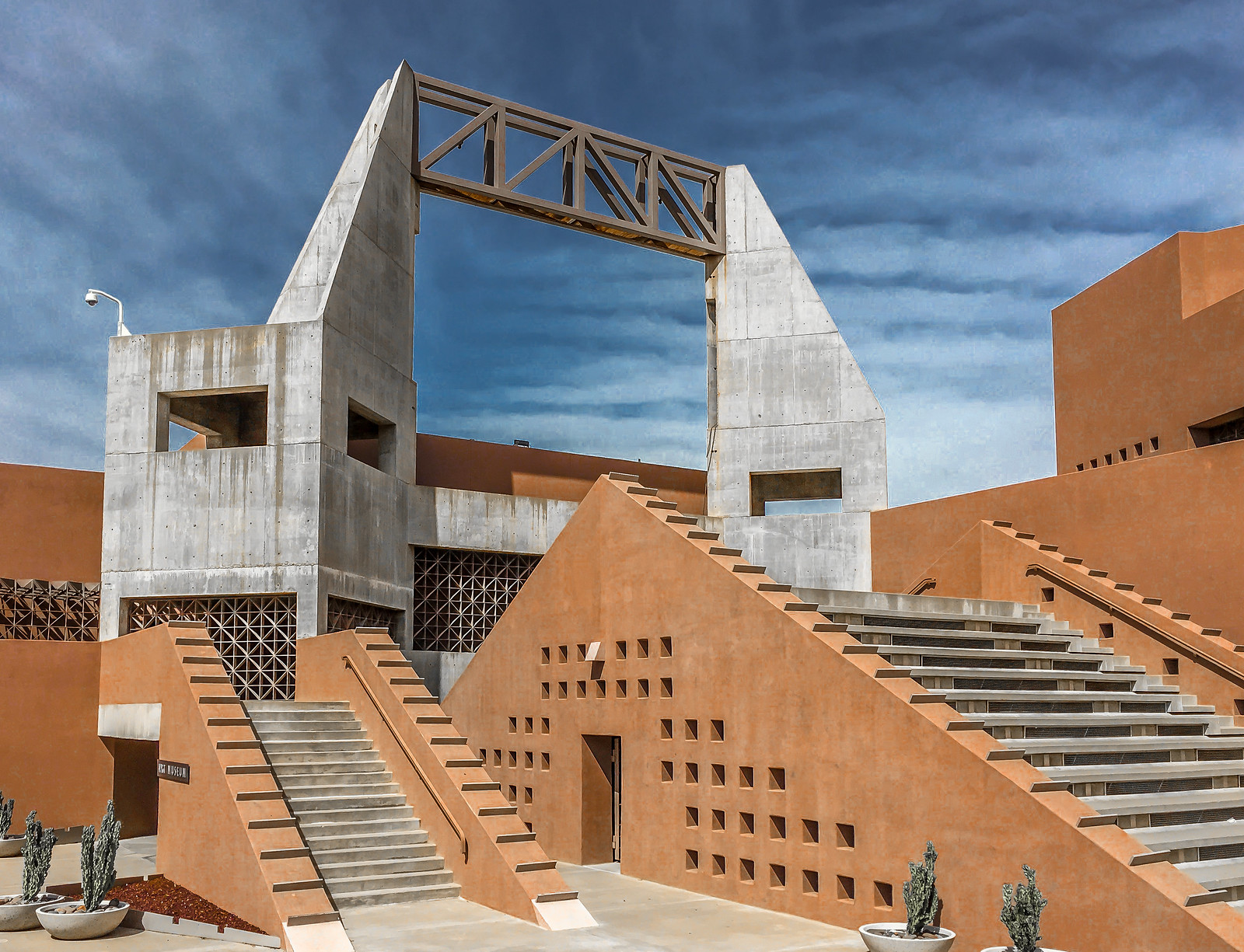 |
| (Source: Kevin Dooley CC BY 2.0) |
Looking to take shelter from that hot Arizona sun? Hop around the shadows cast by the avant-garde architecture of the ASU Art Museum on the western edge of campus. While you’re there, enjoy any of the free temporary exhibitions that feature contemporary art from across the country and the world. Admission is free for students and non-students alike.
Find the ASU Art Museum (51 East 10th Street) at the southeast corner of Mill Avenue and 10th Street.
6) Attend a show at Gammage or Tempe Center for the Arts
 |
| Gammage Memorial Auditorium |
Off-Broadway musicals. Classical performances by students at the ASU School of Music. All that and more takes to the stage of a circular auditorium named for longtime ASU president Grady Gammage. Architect Frank Lloyd Wright took plans for an opera house originally intended for Baghdad, Iraq, and repurposed them for another riverside desert community.
ASU Gammage (1200 South Forest Avenue) sits right inside the curve made by Mill Avenue as it bends southeast into Apache Boulevard.
Tempe Center for the Arts sits mere feet from the lapping waters of Tempe Town Lake’s south shore, its geometric roof sheltering a complex with two theaters and an art gallery. Home to multiple community arts groups, the center also hosts open mic night on Wednesdays for musicians and poets.
The 48 bus toward Priest/Baseline will drop you off right in front of the entrance to Tempe Center for the Arts, whose address is 700 West Rio Salado Parkway.
7) Go to a Spring Training game
 |
| (Source: Kevin Brown CC BY-NC-ND 2.0) |
Tempe’s Diablo Stadium is the spring training home of the Los Angeles Angels. This tradition of spring training has taken place across the entire Phoenix Valley since the 1940s, and today, half of the nation’s MLB teams practice here—to the delight of all the transplants from California and the Midwest. You can watch the Angels play laid-back spring training games in Tempe from late February through most of March.
Tempe Diablo Stadium (2200 West Alameda Drive) sits just south of the Marriott Phoenix Resort Tempe at the Buttes inside the “Broadway Curve” of Interstate 10. From downtown Tempe, take the 48 bus toward Priest/Baseline and get off at 48th Street and Roeser Road/Alameda Drive.
8) Explore Tempe’s Papago Park Preserve
Did you know there used to be a national park in the Phoenix area? Sadly, Papago-Saguaro National Monument was decommissioned by Congress in 1930 and then parceled out into acreages that would become a national guard base, a botanical garden, a zoo, a Phoenix city park, and two golf courses. The southernmost portion of the monument was given to Tempe.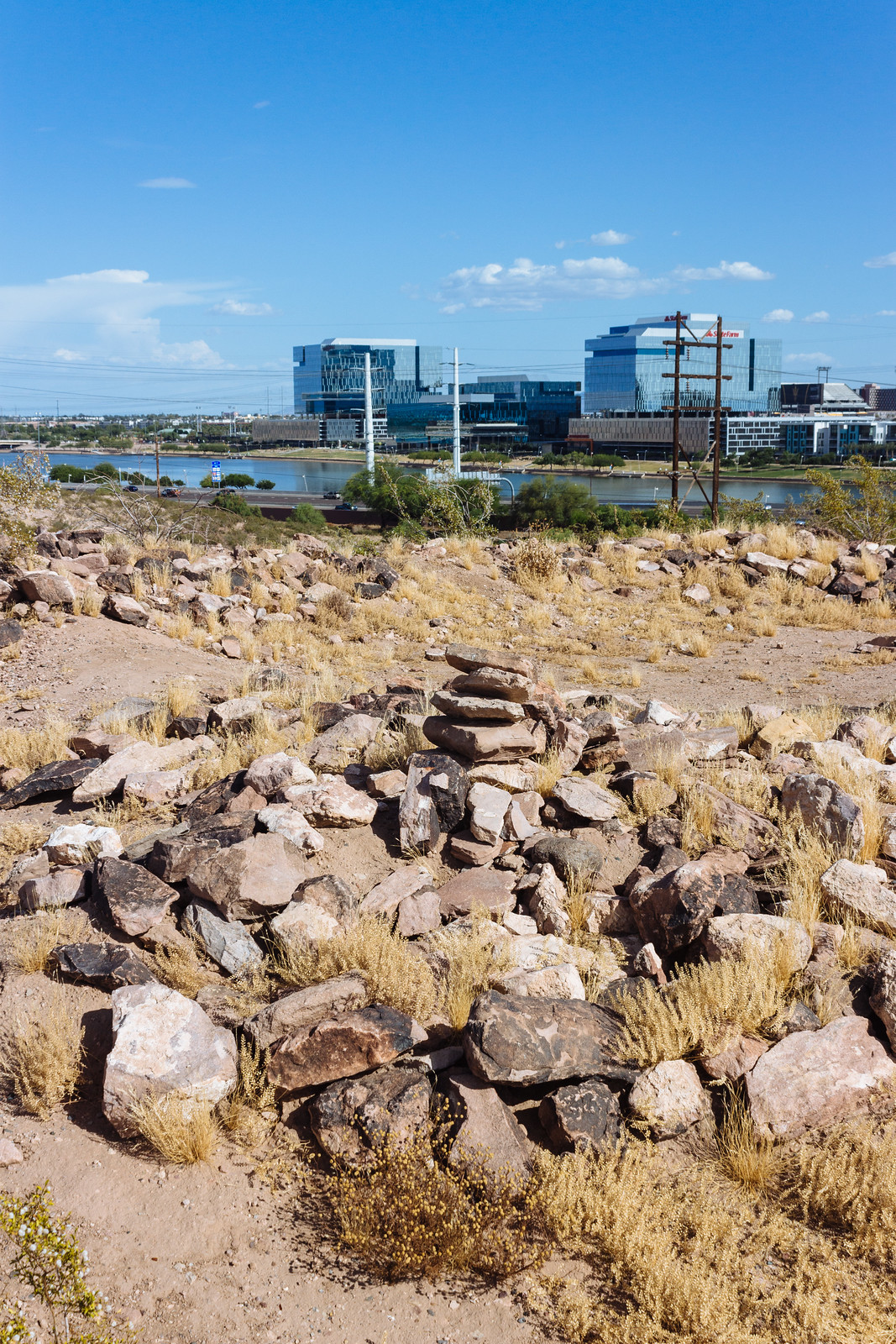 |
| Loma del Río ruins |
In addition to petroglyphs from the prehistoric Hohokam people, Tempe’s also got hilltop ruins from the same era that overlook Tempe Town Lake. Archaeologists excavated the Loma del Rio ruins in 1928, but they carefully buried the crumbling adobe walls in earth in 1994 to protect them against erosion, a common strategy in the Southwest to save dwellings like this one for future studies. What we can see today in Papago Park is just a handful of stones, but the site is evocative nonetheless.
 |
| LoPiano Mesquite Bosque |
The Loop 202 Red Mountain Freeway was first paved through here in the mid-1990s. Its construction created an awkward no man’s land north of the highway and south of an old Papago Park canal. Volunteers worked with the city to revegetate this strip of land by planting mesquite trees native to the Sonoran desert. The LoPiano Mesquite Bosque (Spanish for “forest”) has created a habitat for wildlife and a soothing, shaded place to walk on a summer day.
Find Tempe’s slice of Papago Park north of Tempe Town Lake and State Route 202. If you’re already spending time on the lake, these ruins and the mesquite bosque are nice detours easily accessed on foot via the Mill Avenue bridge. Otherwise, simply drive to the Papago Park parking lot at the intersection of College Avenue and Curry Road or the parking lot on the lake’s north shore further down the road. The free Orbit Earth circulator toward Tempe Marketplace will also drop you off nearby.
9) Learn about Arizona history at the Arizona Heritage Center
 |
| Azurite specimen |
Arizona was known as the Baby State for decades after it gained statehood on Valentine’s Day, 1912, but the state has one of the country’s richest and most interesting backstories. Spend a quiet morning or afternoon at the Arizona Historical Society’s Tempe branch to learn all about the contributions the original inhabitants of the land have made to Arizona history as well as those made by the various waves of settlers who have come to this corner of the Southwest.
Don’t miss the mineral exhibit that showcases Arizona’s mining heritage or a hall that reconstructs the path a series of UFOs called the Phoenix Lights took in the late 1990s.
The Arizona Heritage Center is tucked inside the Tempe portion of Papago Park at 1300 North College Avenue. From downtown Tempe, ride the free Orbit Earth circulator toward Tempe Marketplace and get off at College Avenue and Curry Road.
10) Have fun at concerts, festivals, or athletic competitions
 |
| (Source: Nick Bastian CC BY-ND 2.0) |
As much as I complained about noise and traffic closures when I lived by Tempe Town Lake, I have to hand it to the city for doing their best to host several dozen major special events either downtown or along the lake. They really make the city a fun place to live in! From a New Year’s Eve block party on Mill Avenue and the state’s best Independence Day firework show, to 5Ks, a marathon, and the Ironman triathlon event, there’s always something going on around Tempe Beach Park throughout the year. Check out the community calendar here.

